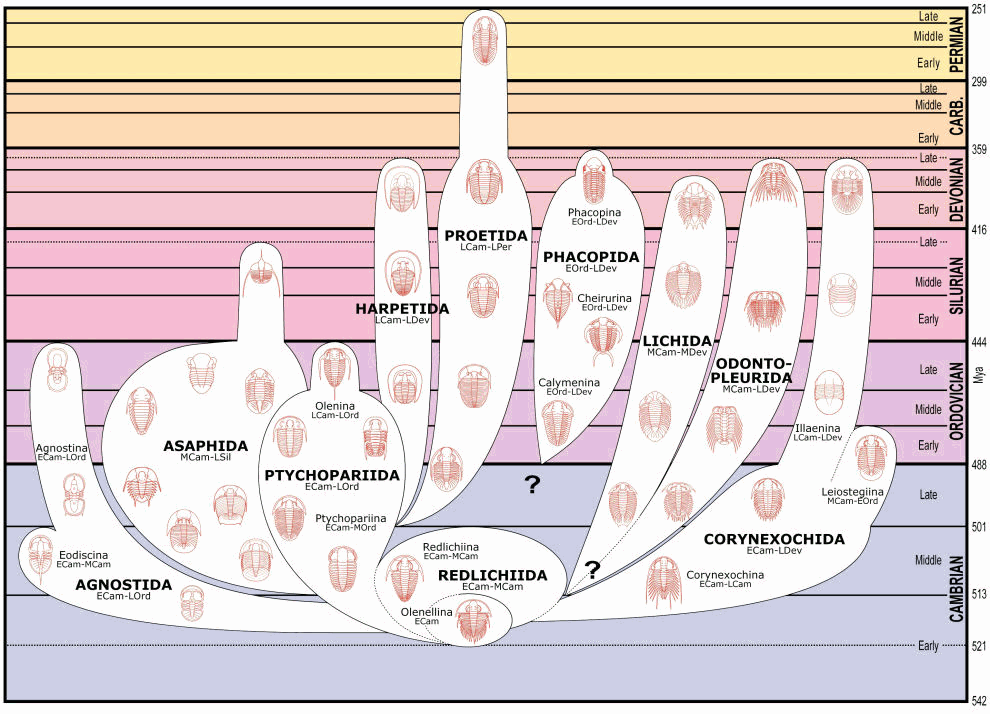| Some
Cambrian trilobites of biogeographic importance |
 |

|

|

|
Earliest
trilobites (e.g., Fallotaspis longa)
FAD determines start of
Series 2, Stage 3
|
Oryctocephalus
indicus
FAD determines start of
Series 3, Stage 5 |
Lejopyge
laevigatus
FAD
determines start of
Series
3, Stage 7 |
Agnostotes
orientalis
FAD
determines start of
Furongian Series, Stage 9 |
 |
 |
 |
 |
Olenellus
gilberti (and other olenellids)
FAD determines start of
Series 2, Stage 4 |
Ptychagnostus
atavus
FAD
determines start of
Series 3, Drumian Stage (6) |
Glyptagnostus
reticulatus
FAD
determines start of
Furongian Series, Paibian Stage (8) |
Lotagnostus
americanus
FAD
determines start of
Furongian Series, Stage 10 |
More
on the Cambrian
The name Cambrian was introduced in geology
by
Murchison and Sedgwick in 1835. The name comes from the Celtic Cambria,
the classical name for Wales, UK, and was used to designate a
thick lithological series there. Only lithological critera was used by
early workers, with little agreement on age or boundaries. Following on
the pioneering works of Smith, Dalman (1827) distinguish two faunas in
Scandinavia,
Olenellus
and
Paradoxides,
and Brögger (1876) recognized their order of appearance (
Olenellus
the earlier). Walcott (1886/1891) used these faunas to establish
disctinctions within the Cambrian that were long-held: An
Olenus fauna was named the Potsdamian, and later, the Upper
Cambrian. A
Paradoxides fauna
was named the Acadian, and defined the Middle Cambrian. The
Olenellus
fauna was named the Georgian, and was considered the Lower Cambrian.
This three-part division of the Cambrian was adopted
by generations of workers, and is only presently being superceded
by the four series system above. The discovery of fossils of
undetermined affinity in strata lower than trilobites (the "small
shelly fossils" fauna) extended the Cambrian lower than it was
previously set, and this pre-trilobite series is now considered
the lowest Cambrian.
For
more information:
Babcock, L.E., S Peng, G. Geyer, & J.H. Shergold. 2005. Changing
perspectives on Cambrian chronostratigraphy and progress toward
subdivision of the Cambrian System.
Geosci.
Journal 9(2):101-6.
Dalman, J. W. 1827. Om Palæaderna eller de så kallade Trilobiterna.
Kungliga Svenska Vetenskaps-Akademiens
Handlingar 1: 226-294.
Geyer, G. & J. Shergold. 2000. The quest for internationally
recognized divisions of Cambrian time.
Episodes
23(3):188-195.
International Subcommission on Stratigraphy. Internatiional
Chronostratigraphic Chart.
http://www.stratigraphy.org/index.php/ics-chart-timescale
Murchison, R. I. 1835. On the Silurian System of rocks.
London
and Edinburgh Philosophical Magazine of Journal Sciences
(series 3) 7: 46-52.
Murchison, R. I. 1854.
Siluria.
The History of the Oldest known Rocks containing Organic Remains, with
a Brief Sketch of the Distribution of Gold over Earth. John
Murray, London, 523 p.
Sedgwick, A. 1852. On the classification and nomenclature of the
Lower Palaeozoic rocks of England and Wales.
Quarterly
Journal of the Geological Society of London 8: 136-168.
Sedgwick, A. 1855 (in SEDGWICK A. & MCCOY F.).
A
Synopsis of the Classification of the British Palaeozoic Rocks with a
Systematic Description of the British Palaeozoic Fossils in the
Geological Museum of the University of Cambridge. University
Press, London; Cambridge, 832 p.
Sedgwick, A. 1873 (in SALTER J. W.).
A
Catalogue of the Collection of Cambrian and Silurian Fossils Contained
in the Geological Museum of the University of Cambridge.
University Press, Cambridge.
Smith, W., 1815, A memoir to the map and delineation of the strata of
England and Wales, with a part of Scotland: John Cary, London, 51p.
Smith, W. 1816-1819, Strata identified by organized fossils containing
prints on coloured paper of the most characteristic specimens in each
stratum: W. Arding, London, 32p., 17 plates.
Smith, W. 1817, Stratigraphical system of organized fossils, with
reference to the specimens of the original collection in the British
Museum: explaining their state of preservation and their use in
identifying the British strata: E. Williams, London, 118p.
Shergold, J.H. 1997. Explanatory notes for the Cambrian correlation
chart. In:
Whittington, H.B. et al.
Treatise on
Invertebrate Paleontology,
Part O, Arthropoda 1 Trilobita (Revised). The Geological
Society of
America and the University of Kansas.
Steno, N. 1669, De solido intra solidum naturaliter contento
dissertationis prodomus: Florence, 76p.
Tormo, N. 2002. La Formation de Coulouma (Cambrien moyen) dans l'unité de Mélagues (Versant Nord de la Montagne Noire, France).
Lithostratigraphie, biostratigraphie et aperçu paléogéographique. Bull. Soc. Et. Sci. Nat. de Béziers: 19(60) 45-104.
Walcott, C. D.
1886. Studies on the Cambrian fauna of North America. Bulletin
of the U.S. Geological Survey 30: 12-13.
Walcott, C. D. 1888. The stratigraphical succession of the
Cambrian faunas in North America. Nature
38: 551.
Walcott, C. D. 1891. Correlation Papers - Cambrian. Bulletin
of the U.S. Geological Survey 81: 1-477.
White, A. Toby.
The Furongian (Late Cambrian). http://www.palaeos.com/Paleozoic/Cambrian/LateCam.html
from the Palaeos
website: White, A.T. & M.A.
Kazlev
(2002-ongoing).
Acknowledgements
Many
thanks to Nicolas Tormo
for
sources, discussions, revisions, and suggestions
during the
development of this page!

Walking Trilobite animation
©2000 by S. M. Gon III


















